My collection is a bit of a patchwork of many wildly different things, and one piece within it is exactly that – a patchwork. And it almost has a patchy name too, ‘Lunar-Ticks’ Picnic’.
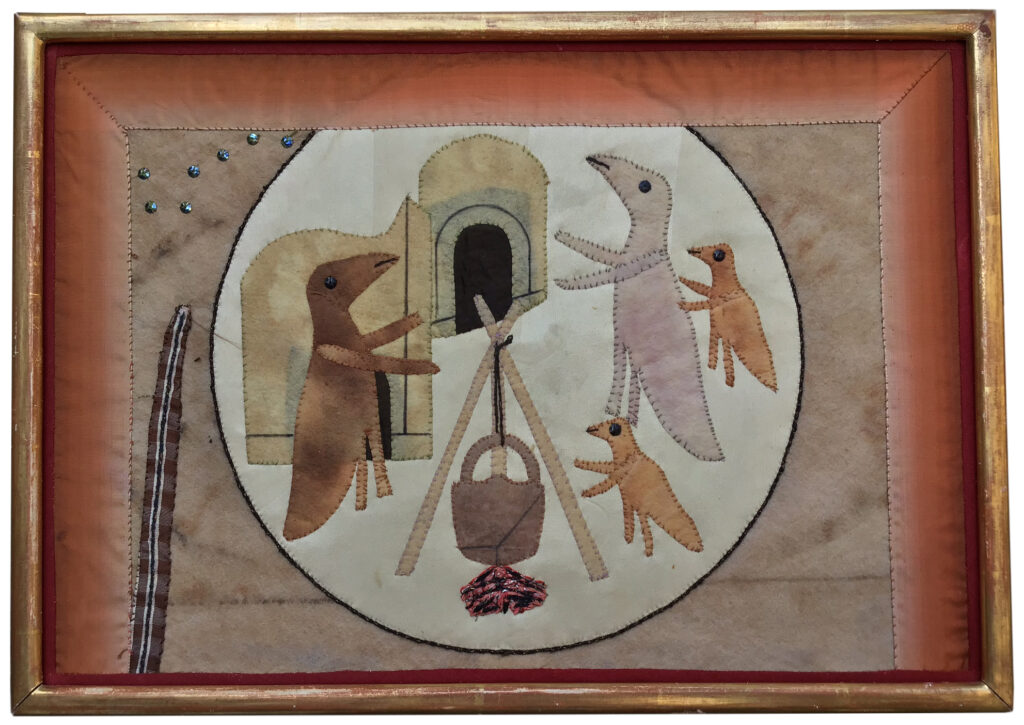
‘Lunar-Ticks’ Picnic’ is a patchwork picture by Miss Elizabeth Allen (1883-1967), and it fits seamlessly into my random collection of textiles. Allen is a name you probably haven’t come across before, and there are many reasons for that. Thankfully, the picture had enough clues to help me uncover the story – and it’s a fascinating one at that.
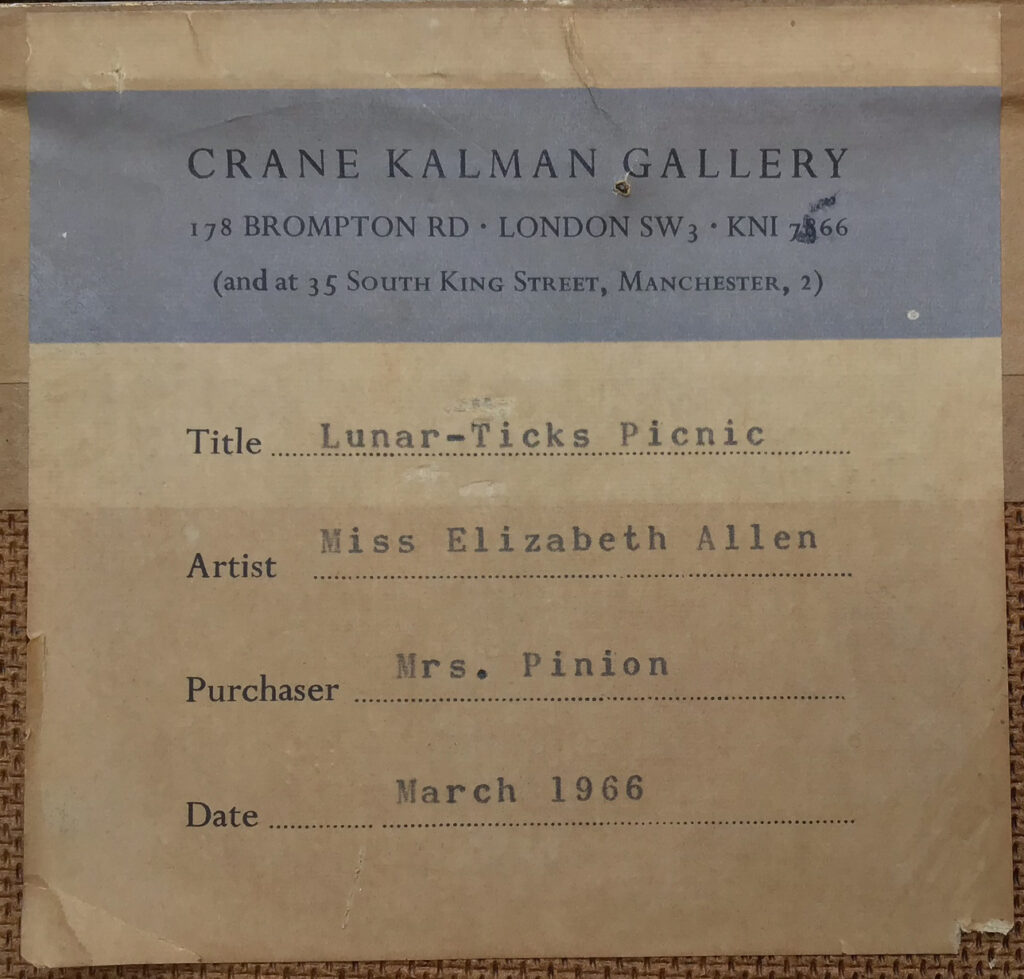
The Back Of A Picture Reveals So Much…
The first clue was a paper label on the back of the picture from the Crane Kalman Gallery, bearing both the picture’s and artist’s names, the buyer of the picture at the exhibition (Mrs Pinion), and the date of the sale. I bought the picture at an auction which included property from the estate of the late Mrs Pinion, making it ‘third hand’ – from Allen to Pinion to me.
The Crane Kalman Gallery sets off all sort of alarm bells in my head. Still in existence today, it was founded in 1949 by the highly influential and avant garde Hungarian dealer and collector Andras Kalman. It specialises in Modern British Art and has held exhibitions of works by L.S. Lowry, Ben Nicholson, Henry Moore, Graham Sutherland, Alexander Calder, André Derain, Sonia Delaunay and many more. Enough said, really! A second label gives the name of the picture, and states that it was made in 1965 when Elizabeth Allen was aged 82. Interesting!
I did a little research online and managed to track down a copy of a catalogue for an exhibition of Allen’s work at Crane Kalman dated 1966. Was my picture in there? Yes. Along with so much more…
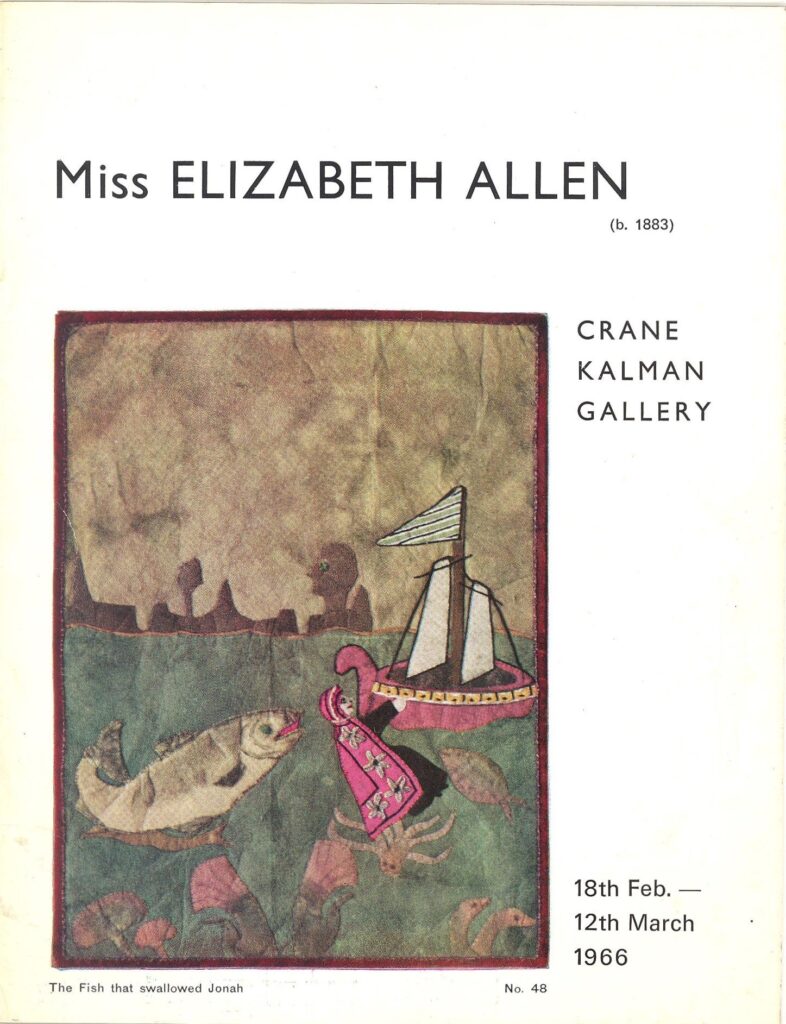
The Catalogue
The introduction to the catalogue is an essay about Allen’s life and work, written by the notable artist Patrick Heron. In it, he explains how his artist friend Trevor Bell had found a “mysterious” old lady working in a hut in the forest near Biggin Hill Sussex who “…was a genius. She made pictures out of rags and the results were fantastically beautiful…”. On December 15th 1965, he went to visit her with Bell, Kit Twyford, and Michael Kidner.
Aged 82, Allen was being cared for by an young art student called Bridget Poole. Allen was known, and referred to herself, by her nickname ‘Queen’. Over tea and biscuits, Allen made comments on some of her pictures, “That’s ‘Midnight Blues’ No More Purple Hearts? Over they go! Suicide!” and revealed some of her inspiration “You see, I’m a religious fanatic.”
Upon their return to London, a dealer for her work was eagerly sought out, and found in Andras Kalman. The group of artists who ‘discovered’ her acted as trustees for Allen to “make these exquisite works known as quickly as possible, for the artist’s sake. … to see to it that the quite remarkable art which Queen has created shall see the light of day”.

Who was Elizabeth Allen?
Elizabeth Allen was born above a baker’s shop in Tottenham, London in 1883 to Mary Anne Allen, from Ireland, and John Koch, who was a German emigré. She was one of 17 children, all of whom changed their names from Koch to Allen after the First World War, to avoid persecution. She learned to sew in her father’s tailoring shop, but her life was “one of great hardship and privation” leading to her being evicted from her Suffolk cottage in 1932. Little else is known, but she became a recluse, living without any connection to the burgeoning Modern British Art movement, and eventually ended up living in a metal hut in a Sussex forest.
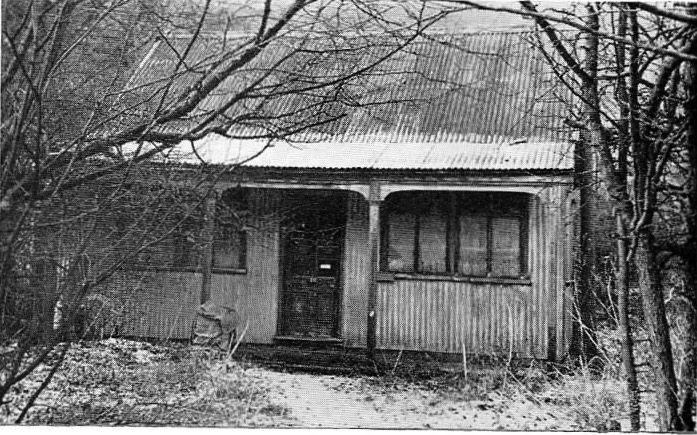
Heron compares her, and the discovery of her work, to the artist Alfred Wallis who was “…the last major phenomenon of this kind – that is, he was an artist of major gifts and minor knowledge – … a case where inexplicable aesthetic sophistication somehow emerged direct out of apparently totally unsophisticated procedures on the part, one might well have thought, of a man who was an aesthetic illiterate (which does not mean that he was not still an artist of genius). But Elizabeth Allen is neither illiterate nor unsophisticated: quite the contrary. … Her genius is therefore innate.”
Heron goes on to compare her work to Persian or Indian Mogul miniatures, Etruscan frescoes, the Egyptian ‘Book Of The Dead’, Ben Nicholson’s Tuscan works, and the work of Paul Klee and Henri Matisse, amongst others. “The range of stylistic analogies suggested by Elizabeth Allen’s work is far wider than is at first apparent.” he said.

He then examines her work, stating that it has developed “from the linear to the planal.” Whereas before she ‘drew’ lines with stitching, she later “…evolved an amazingly precise language of spatial colour: interlocking segments of the design are strongly varied in colour and texture and their recession in space is fantastically controlled. … Surely no embroidery, or fabric collage, or tapestry has in modern times been so purely pictorial in its intention, and in its operation? And how extraordinarily modern, gay, and strong in our colour these works are, and this in spite of the fact that the poetic nature off the world they so strongly and powerfully evoke is as remote as can be from our own age – a sort of fantasy involved with a dream of the Middle East, Biblical, fairy tale, Arabian Nights…”
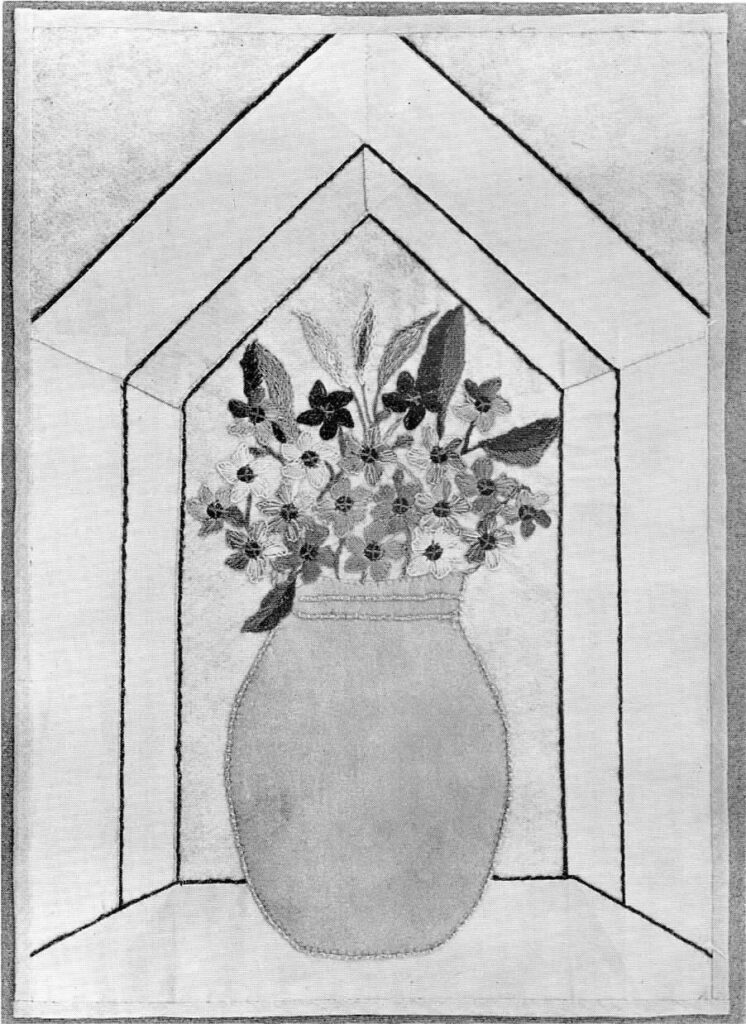
He finishes his introduction by saying “And if there is one gift that is indispensable to the painter, it is that of being able to reduce the sculptural, bulging, complexly three-dimensional lumps and forms and objects of the visible world to flat silhouetted areas of colour, which then mutually interlock. Elizabeth Allen has this central ability, without which no artist is a painter.”
Material Inspiration
Looking at the works illustrated, and their titles, Allen’s work can be divided into those inspired by religions; history; myth and legend; and scenes of normal life. Biblical scenes vie with domestic scenes of daily life, vases of flowers, and powerful works like ‘The Black Feet Are Kicking’ (below) showing men marching across an arid landscape below an enormous pair of feet and a strange monolith with an eye.

Terry Gilliam’s famous opening credits of ‘Monty Python’s Flying Circus’, which first aired three years after this exhibition in 1969, spring to my mind today. And, with the benefit of hindsight and discoveries made since 1966, the life and work of the Kentish tailor George Smart (1774-1846) and the famed naïve artist Grandma Moses (1860-1961) are also both comparable and relevant. However, Allen would obviously not have been inspired by these – the first occurred two years after her death, and it’s almost certain that she never saw Smart’s or Moses’ work.

Living in near poverty for much of her long life, it’s likely that Allen initially gathered fabrics to create her artworks with by taking offcuts from her father’s tailoring shop. These may have been augmented over the years by using old clothes, tablecloths and other fabrics found around and about the house. I’d also like to think that people gave this “mysterious old lady in a wood” materials to work with too. I wonder what she thought of this sudden fame, so late in her life aged 82? If she enjoyed it, she only got to enjoy it for a year or so, as she died in 1967.
So where does my picture fit in?
My picture ‘Lunar-Ticks Picnic’ is listed as no.18 in the catalogue. It shows a group of lizards or dinosaurs (presumably the lunatics?) outside the fronts of buildings around a fire over which a cauldron hangs from a wooden frame. The roundel and the figures are made from differently coloured felts, and a wide silk (?) border frames three sides, itself bordered by a narrow cloth border. The fire is busily stitched in black, green, pink, red and silver metal threads. A strange straight, snake-like form is placed on the left, under seven iridescent sequins. As for inspiration, it’s not religious or mythological to my knowledge. What on earth was she thinking? We’ll never know.

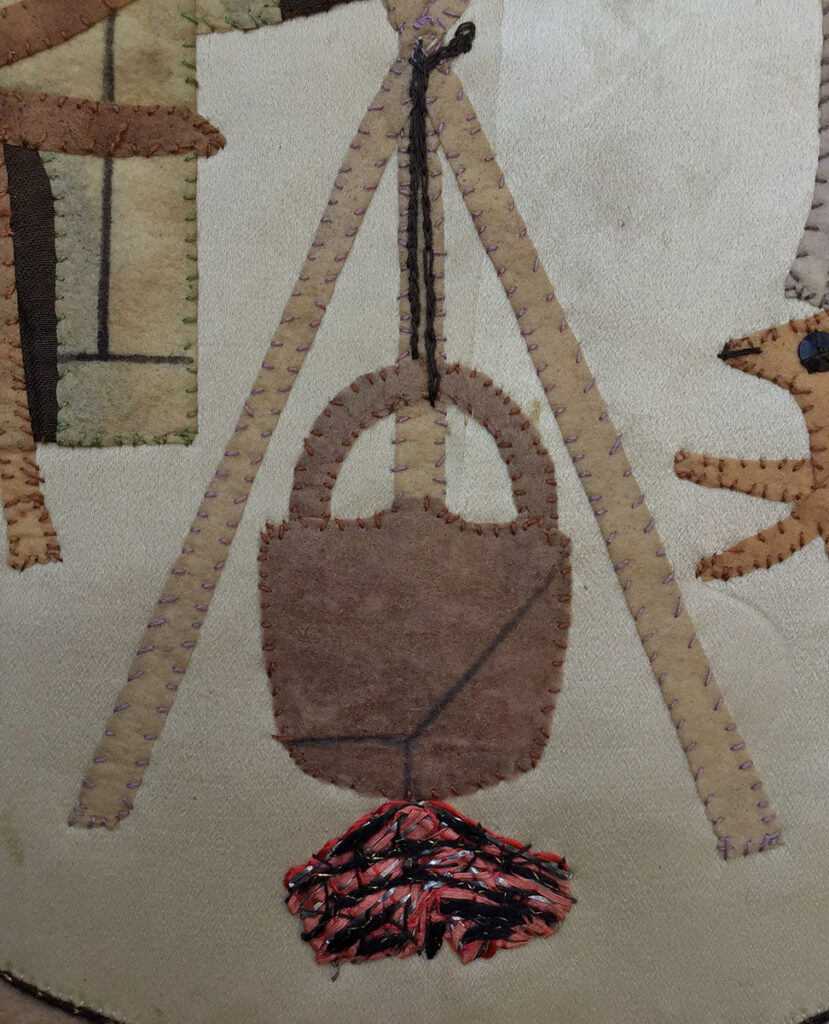
Condition
Sadly, the intervening half century or so hasn’t been kind to it. Crane Kalman framed and glazed it for the exhibition but didn’t put a mount or divider in place, so the fabric was touching the glass. The buyer, Mrs Dilys Pinion (herself an artist), appears to have hung it in strong light, as it looks faded and certainly doesn’t have the vivid and bright colours one usually associates with Allen’s work. But in some places the fading doesn’t make sense for being hung in bright light, such as on the wide border, and some colours still appear vivid. Perhaps it hasn’t faded that much and this was how she intended it?
My patchwork picture isn’t signed and it’s not known if any of her works were. Equally, it’s not known how many works she produced in her long lifetime, or how many have survived. There were 60 pictures in this first exhibition of 1966. Firm attribution to her hand would be extremely difficult without any provenance (like labels), especially given the medium. In 1973 Crane Kalman gave her a second exhibition, six years after her death, where her patchwork pictures were exhibited alongside Alfred Wallis’ paintings. The British Folk Art Collection at Compton Verney contains one picture by her, ‘Population Explosion’, itself from Andras Kalman’s private collection.

Fame, Fortune & The Future
I have wondered why Elizabeth Allen hasn’t received more attention, especially considering Heron’s and Bell’s fame as artists, the fame of the Crane Kalman Gallery, and the fact that Alfred Wallis has received enormous attention, leading to his paintings fetching anything from single or double digit thousands for a drawing to over £100,000 for a painting today. His work can be found in the Tate Gallery and many important collections. Allen’s is only in one museum or gallery – as listed above. The only reason I can fathom is that it is because of the medium – textiles are (incorrectly) typically not considered to be art by most. Even if they are, the medium commands a considerably reduced financial value. Unfair, I shout. I paid just under £70 for ‘Lunar-Ticks Picnic’, but maybe you think I’m a lunatic for even paying that…I don’t.
I’d love to find more patchwork pictures by her, and to find more out about her. Heron mentions an “autobiragraphy” (autobiography) in his introduction as a (suitably) “cloth bound object”, but I’m yet to find any trace of a copy. If you have anything to add to Allen’s story as told here, let me know.

